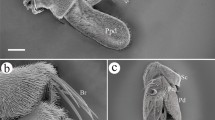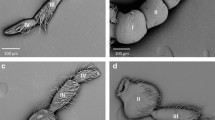Abstract
Antennal sensilla were compared in females and males of two sympatric mymarid Hymenoptera, Anaphes victus and A. listronoti which are, respectively, solitary and gregarious parasitoids of eggs of the carrot weevil Listronotus oregonensis (Coleoptera, Curculionidae). Both species are morphologically very similar in the area where they are sympatric. The external morphology of the sensilla was studied using scanning electron microscopy. Female antennae have seven different types of sensilla, morphologically similar in the two species: trichoid sensilla, which are putative mechanosensilla, sensilla chaetica types 1, 3 and 4, which are presumably contact chemosensilla, and sensilla chaetica type 2 and basiconic and placoid sensilla, which are presumed to be olfactory sensilla. The major difference between the two species is the number of sensilla chaetica type 4, of which 6–9 are found on the antennal club in A. victus, while 10–12 are present in A. listronoti. The antennae of the males of both species are similar in morphology and in the number and distribution of their four types of sensilla, i.e. trichoid sensilla, sensilla chaetica type 1 and basiconic and placoid sensilla.
Similar content being viewed by others
Author information
Authors and Affiliations
Additional information
Accepted: 23 November 1998
Rights and permissions
About this article
Cite this article
van Baaren, J., Boivin, G., Le Lannic, J. et al. Comparison of antennal sensilla of Anaphes victus and A. listronoti (Hymenoptera, Mymaridae), egg parasitoids of Curculionidae. Zoomorphology 119, 1–8 (1999). https://doi.org/10.1007/s004350050076
Issue Date:
DOI: https://doi.org/10.1007/s004350050076




